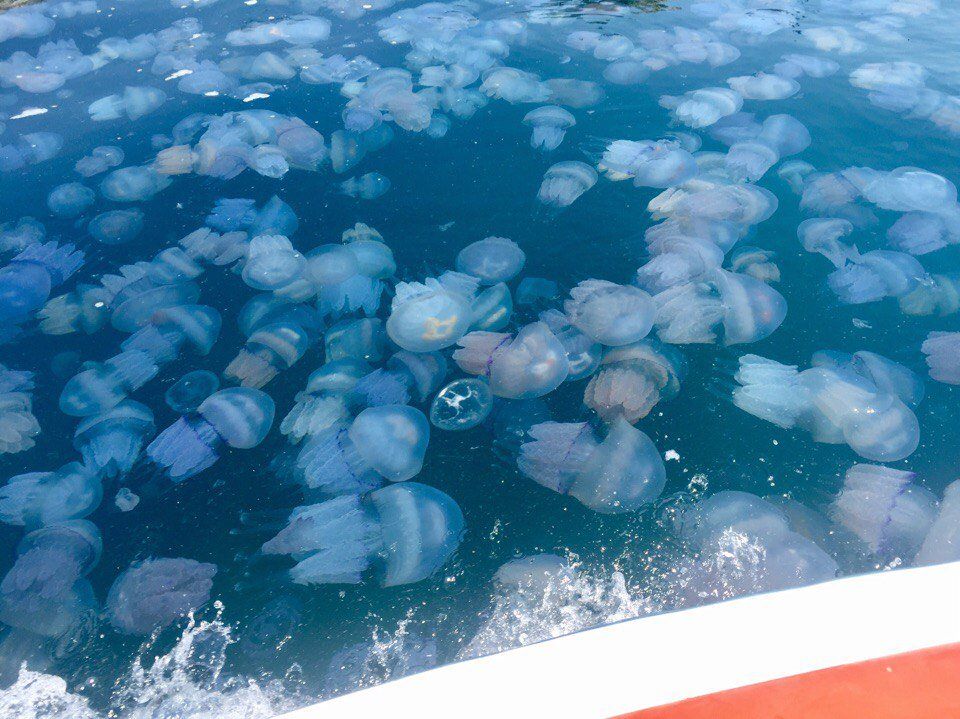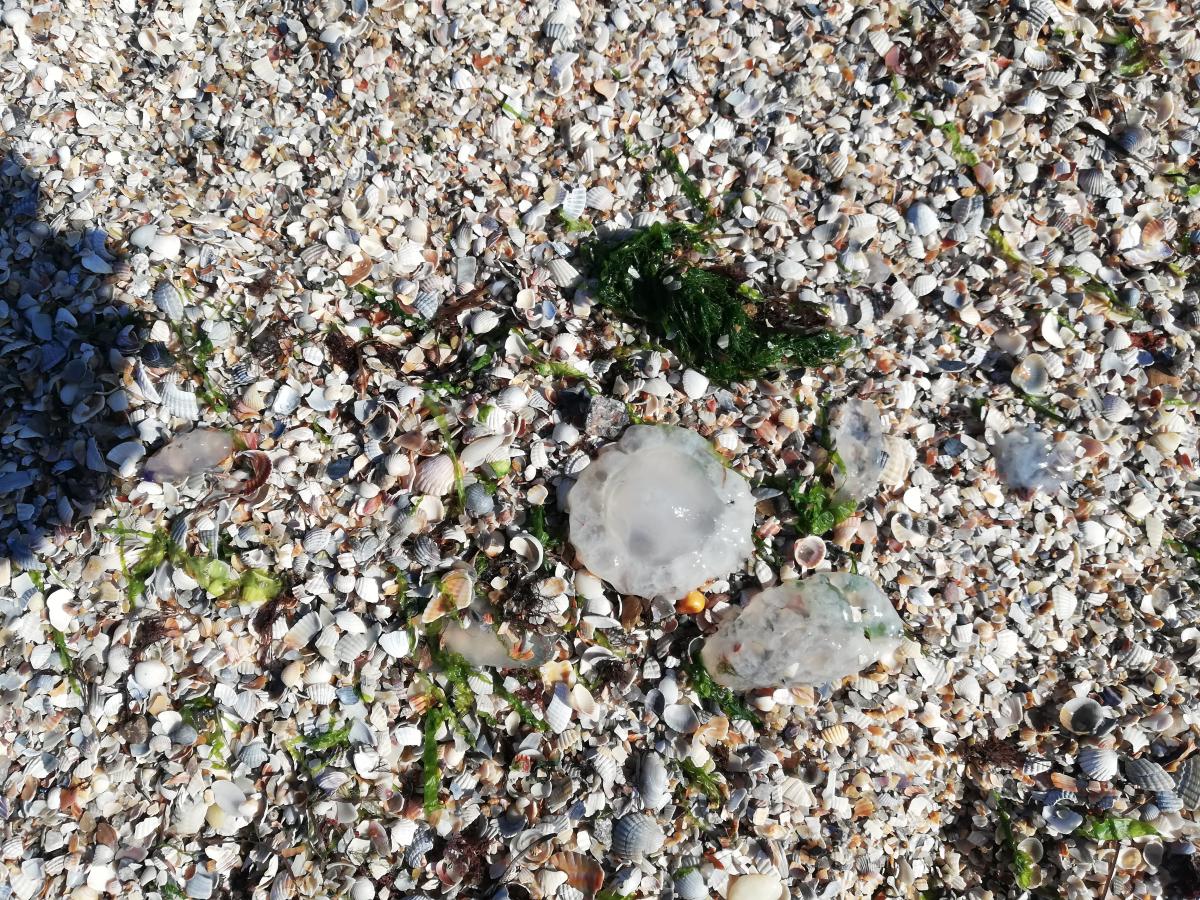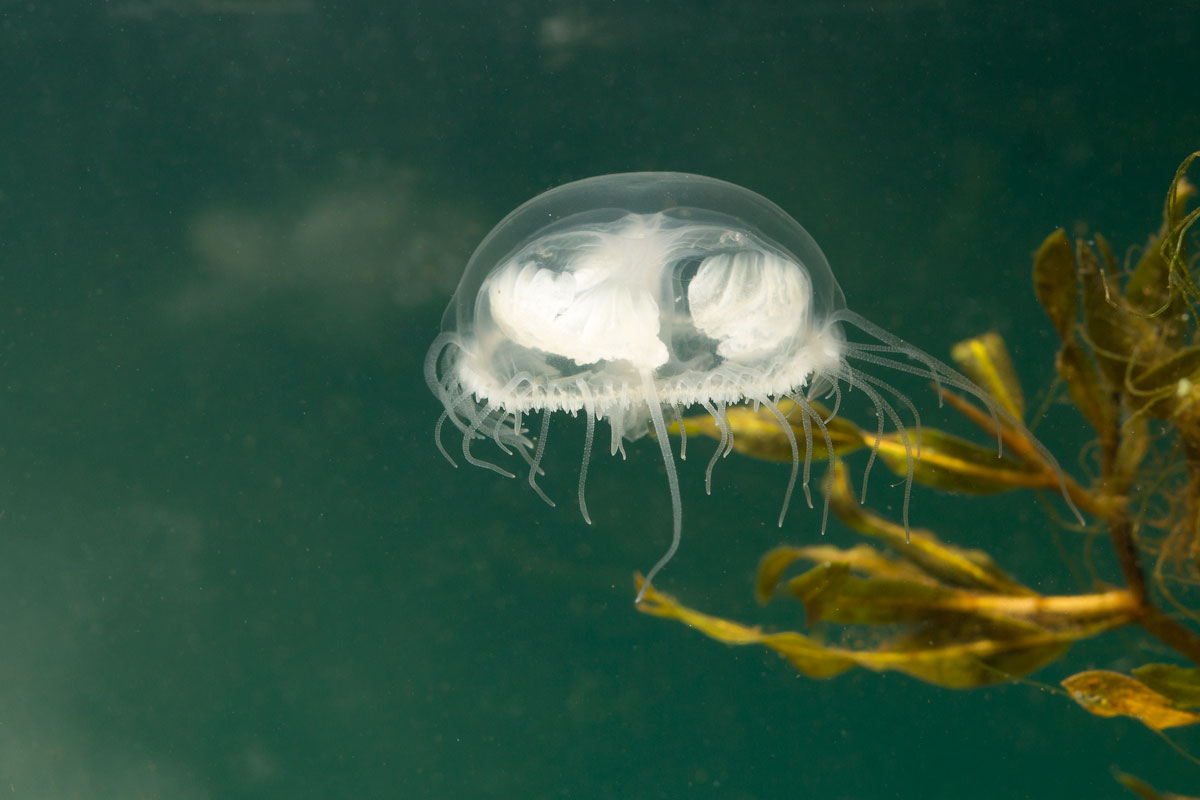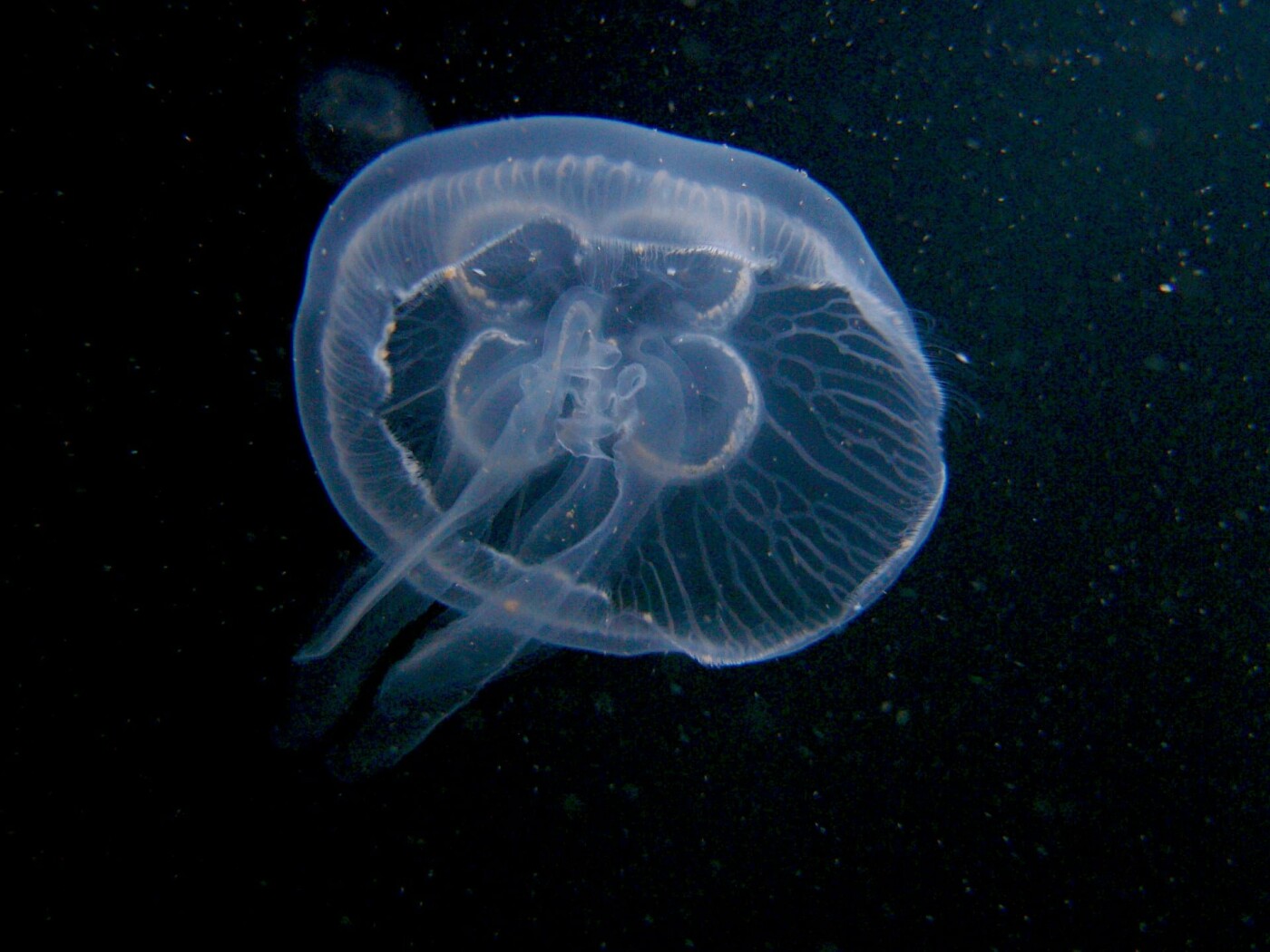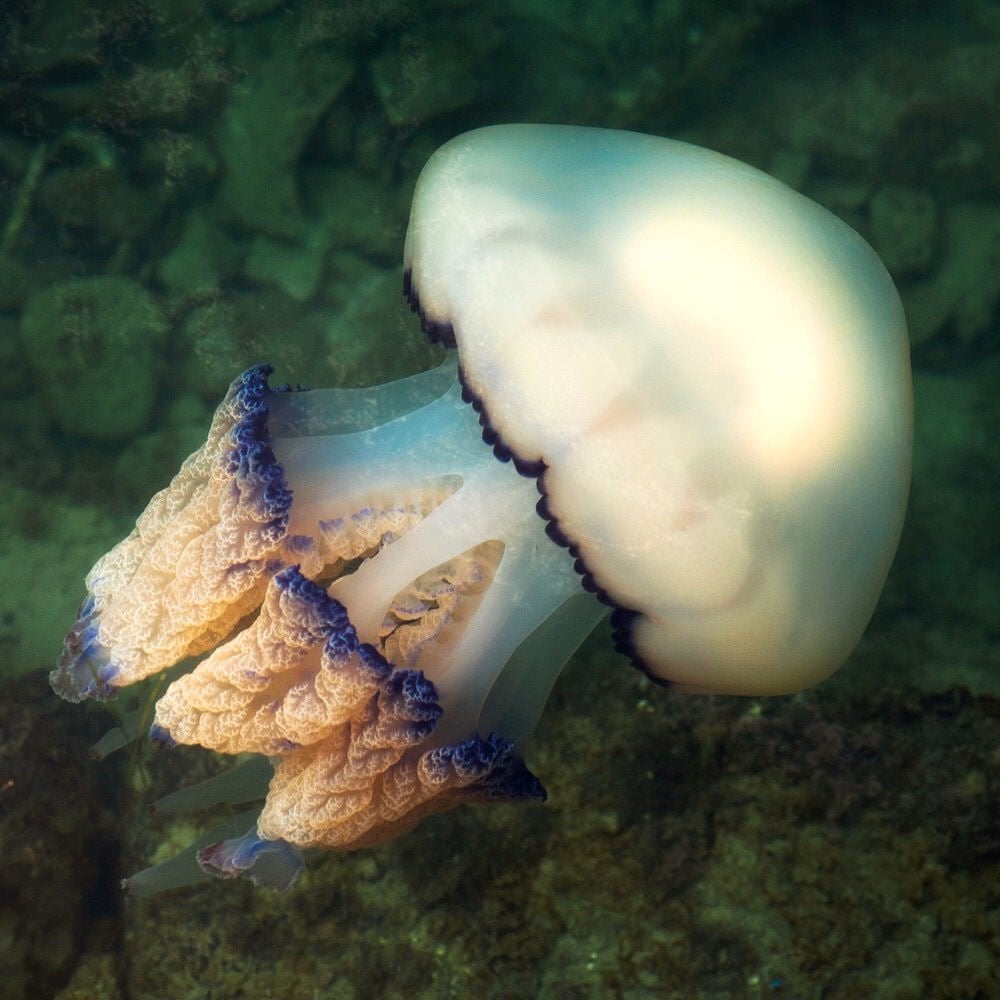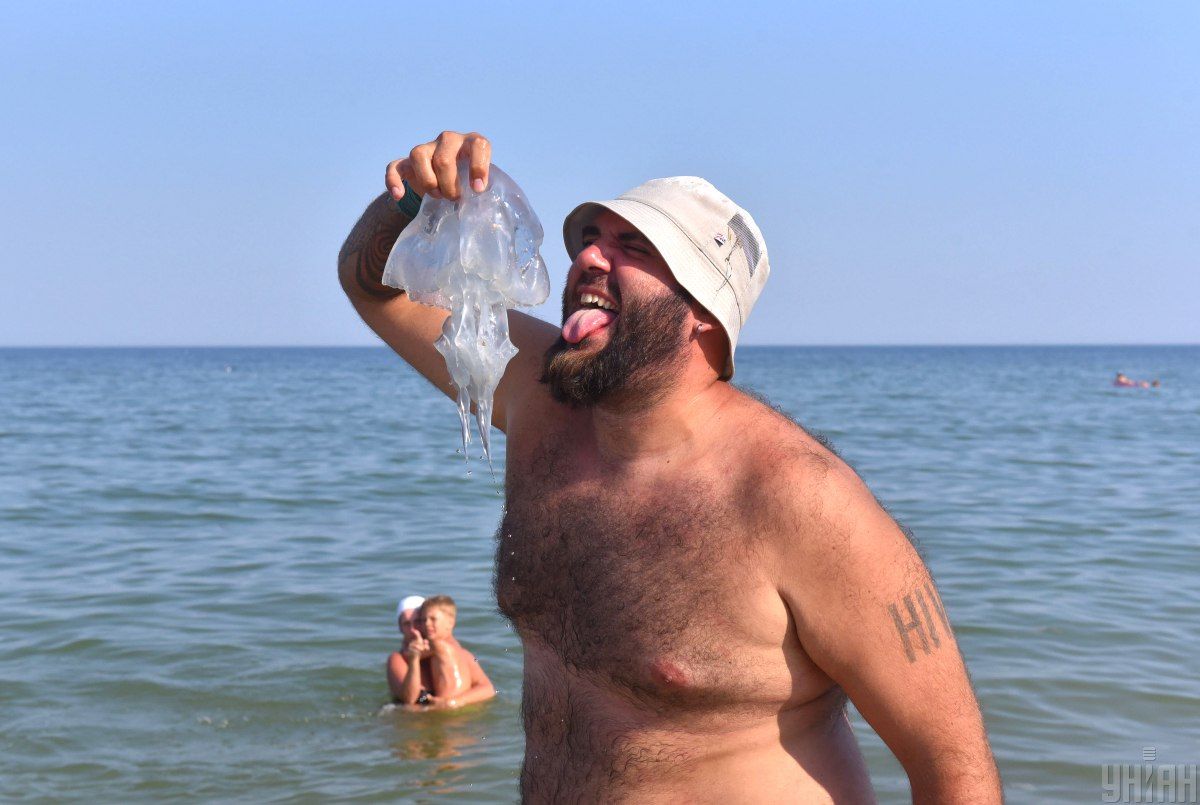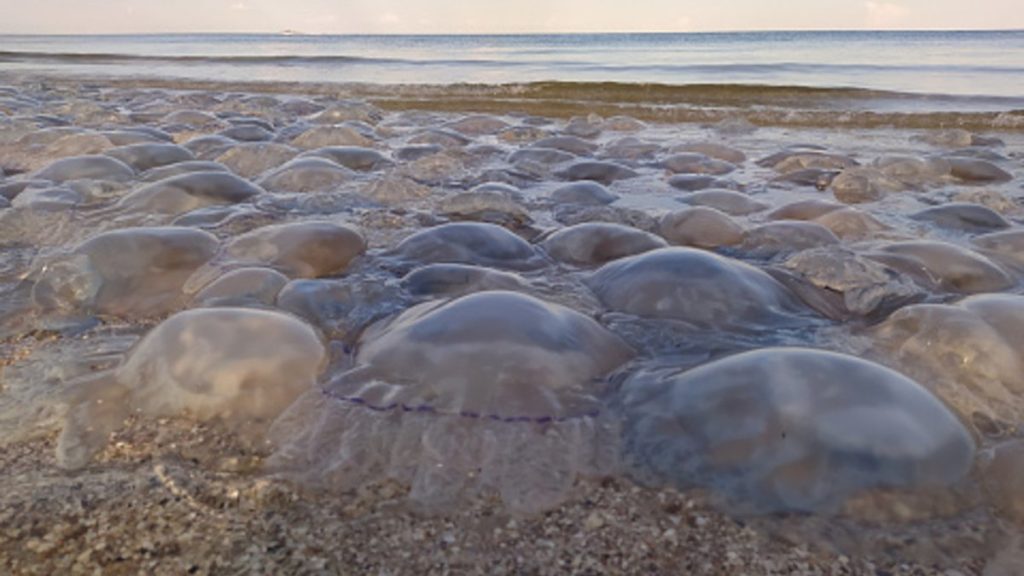Jellyfish invasion in the Sea of Azov: a record set in 50 years and what to do
We're not the first generation to face the invasion of Aurelia and Rhizostomae on the beaches, but the first one to have to learn to live with them.

In the 1970s, the salinity increase in the Sea of Azov was accompanied by an increase in the number of jellyfish, estimated at 2 million tons in 1974, and already exceeded 16 million tons in 1976. Their highest number was recorded in 1978 when there were about seven billion specimens in the sea. Over the course of 40 years, their number has gradually declined, and in 2018, it was estimated at 10 million specimens. But over the past couple of years, the situation has changed a lot.
Friends advised journalist Oksana Sokolova to go to Arabat Spit this year. There's a clean sandy beach and houses in the Malibu style, with huge panoramic windows in the bedroom, twenty meters from the sea. Silence in the evenings and civilized vacationers. But an expected nice vacation was spoiled both from the air and from the sea. Hordes of mosquitoes and jellyfish attacked holidaymakers from all fronts, preventing them from swimming in the sea or opening the huge bedroom windows in the evening to let the sea breeze into the room.

Oksana Sokolova near the holiday house on Arabat Spit, a resort on the Sea of Azov. Source: Facebook
"People come, turn around, and leave… Thousands of jellyfish are removed from the beaches every morning, but there are millions of them."
These are the words of Pavel Vyshebaba.
The same vacation enemies trap tourists all over the Azov coast. People simply cannot enter the water because the water is overflowing with jellyfish. This happens on the beach in Berdiansk: Ukrainians, who expected to spend a week or two on the hot sand, swimming in the warm sea, huddled in the shade, and are afraid to go into the sea. Mountains of dead jellyfish lie at the water, and living jellyfish with large white tentacles that hurt the skin swim right near the shore. Eyewitnesses say there are about five marine inhabitants per square meter.
The video was filmed by vacationers in Kyrylivka, the beach of the Azov Sea in the midst of the swimming season, July 2021:
"There are a lot of people in the rooms, but there is no one in the water"
A crowded beach in Berdiansk, and an empty sea. Mid-July 2021:
A tourist describes this, filming washed jellyfish in shallow water in Kyrylivka. Adults can enter the water only knee-deep, and only those vacationers, by a lucky chance, took a mattress with them to the beach, can swim further, overcoming the jellyfish obstacle. They're also afraid to let children into the water. Because of numerous stranded jellyfish on the beach, the beach smells very unpleasant. Animals begin to decompose in the scorching sun and leave behind a sticky trail on rocks, piers, and sand.
How did it start?
There was also a jellyfish outbreak last year. Locals on the Azov beaches say that there were even more of them in 2020, and they fear that their number will continue to grow in 2021. The Institute of Fisheries and Marine Ecology explains that the dominance of jellyfish results from them having fallen into a favorable ecological niche for them. First, the number of jellyfish in the Black Sea has increased, and jellyfish enter the Azov Strait through the Kerch Strait in spring. The increase in the number is provoked by rather warm winters, which in turn contribute to the successful wintering of even heat-loving jellyfish, and the massive presence of plankton, their food. In addition, the salinity of the Azov Sea is gradually approaching the salinity of the Black Sea and it obviously plays a role due to changes in the water balance of the Azov basin. Earlier, the salinity of the Azov water was low, about 10-12 ppm, but now this figure has grown to 14, and the salinity of the Black Sea is 18 ppm. According to Vera Hetmanenko, head of the laboratory of hydro-biological and ecological-toxicological studies at the Institute of Fisheries and Ecology of the Sea, changes in salinity are a normal process that takes place cyclically for 40 years. Since jellyfish prefer warm salt water, there are more of them in the Sea of Azov. But when the next water freshening begins, and the jellyfish leaves, it's impossible to say for sure.
The factors of Rhizostomae and Aurelia appearing in the Sea of Azov are associated with global natural processes, they've been going on for many years, and a person's ability to influence them is rather conditional, which cannot be said about jellyfish … In the Dnieper! They're different from marine ones. They are peach blossom jellyfish (Craspedacusta sowerbii) and are believed to be of Asian origin, although they're found in freshwater bodies around the world.
The medusoid stage appears when the water temperature reaches 25 degrees Celsius. In recent years, it has happened almost every year. Over the past 7 years, the average monthly water temperature of the Dnieper in June was from 15 to 27 degrees Celsius, in July and August, it was from 19 to 28. Therefore, peach blossom jellyfish isn't a wonder for the Dnieper; it has been recorded over the past 10 years. These jellyfish are safe for humans, as they use the sting only to get their own food. They don't pose a direct threat, but they're a distress signal because their appearance indicates that the Dnieper is becoming shallow and overgrown, therefore, it's possible to "kick out" jellyfish from the Dnieper if water resources are properly distributed, reducing the volume of water consumption, and not so much at the household level, but on the global one, in industry and agriculture.
Jellyfish in the Sea of Azov is mainly represented by two species: barrel jellyfish (Rhizostoma pulmo) and aurelia, or common jellyfish (Aurelia aurita).
Barrel jellyfish reach 60 centimeters or more in diameter. It has a fleshy dome of bluish or purple color, sometimes with a bright edging, with a bunch of thick branched "tentacles," similar to roots, hanging under it. In fact, these are not tentacles, but a modified mouth with esophageal canals, so that the jellyfish sometimes eats with them, and sometimes stings people since the tentacles are covered with stinging cells. In terms of its toxicity, a barrel jellyfish bite can be compared to a nettle burn: unpleasant, but not fatal, unless you're at great depth. A sudden bite can be frightening, make you grab water, and as a result, you can choke and drown.
A common jellyfish is smaller than a barrel jellyfish, up to 40 centimeters in diameter, and resembles a transparent floating umbrella. If you look at it from above, you can see four horseshoes; it's not the mouth, like with barrel jellyfish, but the genitals. The tentacles with stinging cells are located along the edges of the jellyfish dome, and the "bite" of the common jellyfish won't be as unpleasant as after the barrel jellyfish.
People tried to escape from jellyfish on the coast of the Sea of Azov in different ways, but so far an emergency solution to the problem is their usual disposal. Beach workers, utilities, and even the tourists themselves collected dead jellyfish from the shore and hauled them away in wheelbarrows, and sometimes trucks, away from holiday areas. In some places, however, they tried to bury jellyfish right in the sand by the sea, but the story didn't end well: Liudmila Novitska wrote on her Facebook how she fell into a pit with jellyfish on one of the beaches of Kyrylivka, so deep that four men helped her get out. The woman didn't report anything about the burns and injuries received, but we assume that the consequences weren't the most pleasant. There's only one conclusion here: burying jellyfish in the sand right on the beach isn't the best idea.
The most promising solution, according to the scientists from the Institute of the Sea, is to learn to live with jellyfish than to look for radical ways, how to get rid of them altogether. The Institute of Fisheries and Marine Ecology proposes to create sea areas protected from jellyfish near sandy beaches. They report that installing barrier systems isn't a technologically complex undertaking. The Institute actively offers its assistance in their development and creation, and, which is important, taking into account the local natural conditions of marine areas, considering the possible environmental consequences of establishing such systems; research on this topic is now being carried out in a scientific institution.
However, one doesn't have to contact a scientific institute; the barriers are an ordinary net with a weight at the bottom and buoys on top, they are on the Ukrainian market and you can even order them in an online store. The denser the mesh is, the fewer jellyfish will make their way into the water area. Each recreation center could establish similar barriers, and, in many respects, reduce the problem of jellyfish as a factor that harms both the business of providing recreation services by the sea and the health of vacationers.
But in the world, they come up with much more sophisticated methods of protection against jellyfish. For example, surfers in Australia escape the world's most venomous jellyfish, Chironex, also called the Sea Wasp, by wearing regular nylon tights. Surfers and rescuers put the second pair of tights on their hands, cutting a hole in the middle for the head. One cannot escape from Ukrainian jellyfish this way, though: apparently, the poison of Chironex, which can instantly kill a person, is so valuable for the jellyfish that it has learned to distinguish living objects from non-living ones with its tentacles, and stings only if it smelled "real blood." By putting on nylon tights, surfers trick the Sea Wasp into thinking they can't be eaten. So with Ukrainian jellyfish, which are not so smart, this trick, unfortunately, won't do it.
In Australia, they even sell special nylon suits to protect against Chironex, but they cost ten times more than a regular pair of women's tights for $10. Although tights aren't inferior to special suits in terms of protection reliability. Therefore, if you spot a surfer on an Australian beach in tights, don't laugh at him, but rather follow his example if you dare to get into the water.
Not only climate change but also industry can globally affect the number of jellyfish in the sea. This is how the story of the jellyfish's dominance in the 1970s ended. Then a technological line for processing jellyfish into feed additives to the diets of poultry and animals was launched on the Sea of Azov, but it didn't last long, and we know why. The jellyfish were gone. In 2020, the Azov-Black Sea Basin Scientific and Fishing Council in Sevastopol also decided to develop the catch of jellyfish in the Sea of Azov.
Now we can't rule out that the next expansion cycle of jellyfish will end, as it was in the late 70s, but now, at least, we know in what ways we can protect ourselves from them.
I got stung! What to do?
To quickly get rid of the unpleasant sensations after a jellyfish sting, rinse the damaged area in the sea, and then treat with any mixture used for insect bites. The key thing is not to use fresh water, which can activate stinging cells. If you tend to have allergies, it's better to watch out and take an antihistamine, or even better, contact the doctor on duty at the beach. If you rub your eyes or mouth after touching a jellyfish, there may be slight reddening of the mucous membrane of the eyes and mouth.
The same can happen even when touching a dead jellyfish, as long as the stinging cells haven't lost their poisonous properties. Therefore, if the water is overflowing with jellyfish, both dead and alive, after bathing, the body may cover with red spots, as happened with a girl who risked swimming this year on the beach in Kyrylivka. They wrote in the news: according to the child, there were no jellyfish next to her, but there were remains of barrel jellyfish (we remember about stinging cells), which provoked such a reaction.
What is the threat?
In summer, barrel jellyfish predominate in the coastal area, and common jellyfish love cooler water. Besides harming human health because of burns and organic pollution of the reservoir, jellyfish also act as powerful competitors of valuable commercial fish, which, like jellyfish, consume plankton. Moreover, jellyfish can directly destruct small larvae and the eggs of pelagic fish. Rhizostoma pulmo and Aurelia aurita are two of the eight taxa of jellyfish that affect fisheries worldwide. Out of 100% of studies of all types of jellyfish, up to 80% falls on these two species. For example, a 2011 study by John Baxter of the University of Sussex in England states that large populations of Pelagia noctiluca and Aurelia jellyfish in Northern European waters led to profound pathological changes in the respiratory system of local fish populations. The same is happening in the Azov and Black Seas and now. Last year, Sevastopol announced that the total catching in the Sea of Azov decreased by 28.6%, which is associated with a sharp decline in the population of anchovy or, as it's also called, European anchovy. Then scientists expressed the opinion that this led, among other things, to an increase in the number of jellyfish. It was decided to reduce the volume of anchovy catching, but at the same time, the fishing industry won't lose its income, but will only change the vector for some time.
And what can be the benefit?
Jellyfish could be an excellent industrial project for Ukraine. The current annual world catching of jellyfish is about 300-320 thousand tons. Fibrillin, obtained from jellyfish, is used as a tonic for hair, as well as a component that prevents skin aging. It's also used to treat burns. The toxin isolated from jellyfish is used to treat neuromuscular disorders. Jellyfish is the object of research for the search for substances useful in anticancer and antidiabetic therapy. Chinese cooking and traditional medicine have been using jellyfish for over 1,700 years. What about China! Even Ukrainian cuisine masters have already learned how to cook them!
Both common jellyfish and barrel jellyfish can be eaten, so the chef from Berdiansk Mykyta Smakovskyi created jellyfish tartare and Chinese salad from them. The daredevils who tried the unusual dish reported that jellyfish tasted like jelly or jelly with the taste of seawater. The cook doesn't recommend preparing such a dish at home, though: if you don't separate the edible part from toxic substances right and eat jellyfish meat, this can be life-threatening.


